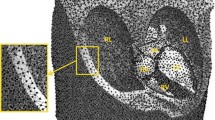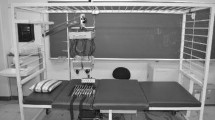Abstract
Potentials recorded on the body surface from the heart are of a spatial and temporal function. The 12-lead electrocardiogram (ECG) provides a useful means of global temporal assessment; however, it yields limited spatial information due to the smoothing effect caused by the volume conductor. In an attempt to circumvent the smoothing problem, researchers have used the five-point method (FPM) to numerically estimate the analytical solution of the Laplacian with an array of monopolar electrodes. Researchers have also developed a bipolar concentric ring electrode system to estimate the analytical Laplacian, and others have used a quasi-bipolar electrode configuration. In a search to find an electrode configuration with a close approximation to the analytical Laplacian, development of a tri-polar concentric ring electrode based on the nine-point method (NPM) was conducted. A comparison of the NPM, FPM, and discrete form of the quasi-bipolar configuration was performed over a 400 × 400 mesh with 1/400 spacing by computer modeling. Different properties of bipolar, quasi-bipolar and tri-polar concentric ring electrodes were evaluated and compared, and verified with tank experiments. One-way analysis of variance (ANOVA) with post hoc t-test and Bonferroni corrections were performed to compare the performance of the various methods and electrode configurations. It was found that the tri-polar electrode has significantly improved accuracy and local sensitivity. This paper also discusses the development of an active sensor using the tri-polar electrode configuration. A 1-cm active Laplacian tri-polar sensor based on the NPM was tested and deemed feasible for acquiring Laplacian cardiac surface potentials.










Similar content being viewed by others
REFERENCES
Besio, W., C. C. Lu, and P. P. Tarjan. A feasibility study for body surface cardiac propagation maps of humans from Laplacian moments of activation. Electromagnetics 21:621–632, 2001.
Fattorusso, V., and J. Tilmant. Exploration du champ electrique precordial a l’aide de deux electrodes circulaires, concentriques et rapprochees. Arch. Mal du Coeur. 42:452–455, 1949.
He, B., and D. Wu. Laplacian electrocardiography. Crit. Rev. BME 27(3–5):285–338, 1999.
He, B., and R. J. Cohen. Body surface Laplacian ECG mapping. IEEE Trans. BME 39(11):1179–1191, 1992.
He, B., and R. J. Cohen. Body surface Laplacian mapping in man. IEEE EMBS 13(2):784–786, 1991.
Huiskamp, G. Difference formulas for the surface Laplacian on a triangulated surface. J. Comput. Phys. 95(2):477–496, 1991.
Lapidus, L., and G. F. Pinder. Numerical Solution of Partial Differential Equations in Science and Engineering. New York: John Wiley & Sons, Inc.,1982, 371–372.
Lian, J., G. Li, J. Cheng, B. Avitall, and B. He. Body surface Laplacian mapping of atrial activation in normal subjects. Med. Biol. Eng. Comput. 40(6):650–659, 2002.
Li, G., J. Lian, P. Salla, J. Cheng, P. Shaw, I. Ramachandra, B. Avitall, and B. He Body surface Laplacian mapping of ventricular depolarization in normal subjects. J. Cardiovasc. Electrophysiol. 14(1):16–27, 2003.
Lu, C. C., and P. P. Tarjan. An ultra high common mode rejection ratio (CMRR) AC instrumentation amplifier for Laplacian electrocardiographic measurements. Biomed. Instr. Tech. 76–93, Jan–Feb, 1999.
Oosterom, A. V., and J. Strackee. Computing the lead field of electrodes with axial symmetry. Med. Biol. Eng. Comput. 21:473–481, 1983.
Ames, W. F. Numerical Methods for Partial Differential Equations. New York: Barnes & Noble, Inc. 1969, 15–19.
ACKNOWLEDGMENTS
The authors thank Louisiana Tech University Center for Entrepreneurship and Information Technology, Louisiana Board of Regents (grant # LEQSF (2003–05)-RD-B-05), and the NCIIA for financial support and our lab associates and Dr. Aijun Besio for their assistance in this research and manuscript.
Author information
Authors and Affiliations
Corresponding author
APPENDIX
APPENDIX
Since the proposed quasi-bipolar electrode shown in Fig. 2 has equal interelectrode distance, the analysis of the nine-point arrangement formed by points p 1 through p 8 and p 0 of Fig. 1, with the same interpoint distance, is considered. Voltages v 0 through v 8 are the potentials at these points. Each potential in this nine-point arrangement can be written in the form of a Taylor series expansion as explained by Huiskamp.6
The average of the outer potentials v 5, v 6, v 7, and v 8 after the Taylor series expansion becomes
The average of the potentials v 1, v 2, v 3, and v 4 after the Taylor series expansion becomes
Adding v 0 to both sides of (A.1) and then dividing by 2 gives
Subtracting (A.2) from (A.3) results in
From (A.4) the approximate solution for the Laplacian of the potential at p 0 can be estimated. Therefore, the Laplacian at p 0 is
where \(O(r^2 ) = \frac{2}{{r^2 }}[O(r^4 )] = \frac{{7r^2 }}{{48}}\left. {\left( {\frac{{\partial ^4 v}}{{\partial x^4 }} + \frac{{\partial ^4 v}}{{\partial v^4 }}} \right)} \right|_{_{p_0 } } + \cdots\) is the truncation error.
Equation (A.5) can also be generalized to the quasi-bipolar concentric ring electrodes, neglecting the truncation error O(r 2). By applying a similar procedure as was used for the bipolar electrode configuration, performing the integral along a circle of radius r around point p 0 of the Taylor expansion and defining X = r sin(θ) and Y = r cos(θ)6 result in (A.6), which is the potential on the middle ring.
Similarly performing the integral along a circle of radius 2r around p 0 and defining X = 2r sin(θ) and Y = 2r cos(θ)6 result in (A.7), which is the potential on the outer ring.
Adding the potential of the disc, \(\int\nolimits_0^{2\pi } {v_0 \,d\theta }\), to both sides of (A.7) and then dividing by 2 results in the average of outer ring and center disc potentials, representing the short in the quasi-bipolar method. This results in
Neglecting the truncation error and subtracting Equation (A.6) from (A.8) result in a proportionate approximation (A.9) to the Laplacian at point p 0 using the quasi-bipolar concentric ring electrode.
where \(\frac{1}{{2\pi }}\int\nolimits_0^{2\pi } {v(r,\theta )\,d\theta }\) and \(\frac{1}{{2\pi }}\int\nolimits_0^{2\pi } {v(2r,\theta )d\theta }\) represent the average potentials on the middle ring and outer ring, respectively.
Rights and permissions
About this article
Cite this article
Besio, W., Aakula, R., Koka, K. et al. Development of a Tri-polar Concentric Ring Electrode for Acquiring Accurate Laplacian Body Surface Potentials. Ann Biomed Eng 34, 426–435 (2006). https://doi.org/10.1007/s10439-005-9054-8
Received:
Accepted:
Published:
Issue Date:
DOI: https://doi.org/10.1007/s10439-005-9054-8




